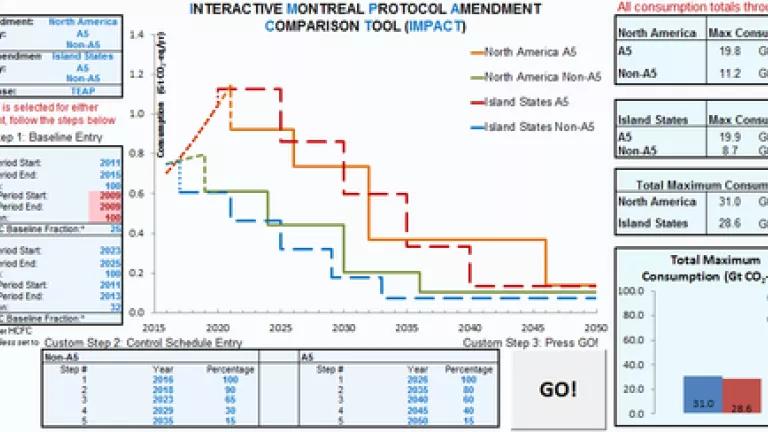Global HFC phase down makes slow but steady progress, with India among nations pushing forward

Guest Post by Bhaskar Deol and Morgan Capilla
The parties to the Montreal Protocol convened at the 36th Open-Ended Working Group (OEWG) meeting in Paris last week. The meeting's primary objective was to review the four proposals and agree upon a strategy to manage dangerous heat-trapping gases, hydrofluorocarbons (HFCs) under the Montreal Protocol. Despite widespread support to formalize an HFC phase down, opposition from a handful of nations prevented the meeting from reaching a conclusion. The parties will now schedule an additional meeting session before their annual meeting in Dubai this November. The additional session will provide the opportunity to iron out necessary details that need to be addressed before it will be possible to make headway on the HFC agreement Dubai.
HFCs are commonly used as refrigerants in air conditioning and cooling systems, but have a devastating global warming effect. CEEW, a leading policy research institution in India, recently published a report that estimates the serious climate impacts affiliated with HFC use in India. If left unchecked, HFC emissions in India could yield the equivalent of 500 million tons of carbon dioxide by 2050. CEEW's report could boost public awareness in India regarding the environmental hazards posed by HFC emissions.
Summary of Montreal Protocol Amendment Proposals: Updated Comparison Chart and the New IMPACT Tool
Government leaders across the world are recognizing the critical need to phase down HFCs, powerful greenhouse gases that pack thousands of times more global warming potential than carbon dioxide. This year, nearly forty countries have come together to put forth four proposals to amend the Montreal Protocol to phase down these gases. India, the United States, Canada, Mexico, the European Union, and a group of Island States are amongst the groups pushing forward amendment proposals to phase down HFCs under the Montreal Protocol.
NRDC along with partners including India's Council on Energy, Environment and Water (CEEW), the Institute for Governance and Sustainable Development (IGSD), and climate expert Steve Seidel prepared a summary chart conveying key elements of the four amendment proposals. To view the chart, click here.
One of the common aims for all the proposed amendments is to achieve help curb climate change by phasing down production and consumption of HFCs. To illustrate the potential climate impacts of each amendment proposal, NRDC created the Interactive Montreal Protocol Amendment Comparison Tool (IMPACT). IMPACT is an interactive Excel-based model that allows users to convert the HFC reduction targets of each proposal into its resulting climate benefits, expressed in equivalent carbon dioxide emissions, and maps the reductions based on the proposal's timeline. NRDC is making IMPACT available for free to parties and observers interested in carrying out this analysis. Click here to view a sample output from IMPACT, comparing proposals submitted by North America and the Islands States.
Innovative technologies now offer more energy-efficient refrigerants that have far less global warming power. Earlier this month, India's Ministry of Environment, Forests, and Climate Change met with government and industry representatives to discuss climate-friendly alternatives to HFCs. Promoting a consensus among government officials and industry leaders on HFC alternatives could help build strong domestic support for an amendment to the Montreal Protocol.
The United States also made huge progress against HFCs this month. On July 2, the US Environmental Protection Agency released new regulations to discontinue select uses of HFCs by 2018. The EPA expects that these new policies will reduce emissions by the equivalent of 54-64 million metric tons of carbon dioxide by 2025.
As the Parties to the Montreal Protocol tackle HFC use within their own borders, they also sustain the international conversation surrounding an amendment to the Montreal Protocol. On the eve of the Paris climate negotiations, these individual advancements could generate the momentum needed to formalize a global plan to phase down HFCs, reduce greenhouse gas emissions, and fight climate change.
To learn more about HFCs:
Reducing Stress on India's Energy Grid: The Power Sector Benefits of Transitioning to Lower Global Warming Potential and Energy Efficient Refrigerants in Room Air Conditioners, March 2015
http://www.nrdc.org/international/india/files/india-energy-grid-alterna…
Energy Efficiency Gains with Lower Global Warming Impact: A Profile of Air Conditioners Using R-290, November 2014
http://ceew.in/pdf/ceew-nrdc-a-profile-of-air-conditioners-using-r290-3…
Energy Efficiency Gains with Lower Global Warming Impact: A Profile of Air Conditioners Using R-32, November 2014
http://ceew.in/pdf/ceew-nrdc-a-profile-of-air-conditioners-using-r32-30…
Cooling India with Less Warming: The Business Case for Phasing Down HFCs in Room and Vehicle Air Conditioners, December 2013
http://www.nrdc.org/international/india/files/air-conditioner-efficiency-IP.pdf
To receive a copy of the IMPACT tool, please contact:
Alex Hillbrand, NRDC HFC Technical Analyst and developer of IMPACT, ahillbrand@nrdc.org
